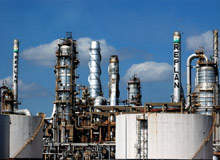
Petrobras Paulínia refinery, also called Replan, started operating in 1972 and is the biggest refinery in Brazil. It is 118km from São Paulo. Construction of the refinery started in July 1969 in a 9.1km² area donated by Paulínia City Hall to Petrobras.
The refinery has a production capacity of 360,000bpd. It initially had a capacity of 126,000bpd. The refinery produces diesel fuel, gasoline, LPG, naphtha, kerosene, coke, asphalt, solvents and propene. In 2009 the refinery started producing metropolitan and interior diesel fuels with low sulphur content. The refinery also started production of S50 diesel with 50ppm.
Replan’s production accounts for 20% of Brazil’s oil refining capacity. The refinery processes about 80% of domestic oil, the majority of which comes from the Campos Basin offshore Rio de Janeiro. Construction of the refinery helped Brazil save about $200m in foreign exchange annually.
Replan is located in an area that provides quick access to the main highway. Rail and air transport are also available.
Extension
Replan is undergoing modernisation following an investment of $3.5bn. The process will increase production capacity to 415,000bpd and allow the refinery to produce diesel and gasoline with lower sulphur contents, meeting guidelines set by the US and European countries. Low sulphur content diesel and gasoline are expected to improve Petrobras’ stake in the international market. In addition, sulphur removed during the refining process will be transformed and sold as raw material.
Petrobras is also investing in innovations that will make the refinery more environmentally friendly by recovering energy and reusing steam and water. The modernisation will generate about 6,000 jobs.
Construction
Construction of the three separation towers of the propene unit was a major achievement for UTC Engenharia. In August 2008 the lifting of the largest tower, which weighs 900t and is 106m high, was the biggest vertical lift performed in Brazil. The other towers weigh 240t and 285t.
The largest crane ever used in Brazil hoisted the towers into position. The crane was provided by Netherlands-based Mammoet and was transported from Asia in 110 containers and assembled at the refinery.
Contractors
Contracts for the modernisation were awarded to several companies. They included UTC, Andrade Gutierrez and a consortium of Consórcio Mendes Junior and MPE / SETAL UTC.
The consortium of Consórcio Mendes Junior, MPE and SETAL was awarded a contract in January 2008 for construction of two hydrodesulphurisation (HDS) units of cracked naphtha and a substation. Mendes Junior is responsible for the project’s implementation.
The new HDS units will improve the quality of gasoline produced at the refinery. Gasoline currently produced at Replan has 1,000ppm sulphur. With the construction of the new units, the sulphur content will be reduced to 50ppm.
The work includes implementation of the project, execution, construction, electromechanical assembly, conditioning, pre-operation, starting and assisted operation of the plants.
In 2008 Andrade Gutierrez, a Brazilian construction company, was awarded the contract to build new units to allow the plant to hydrotreat 8,500m³/day of diesel.
In 2003 Emerson Process Management was awarded a $7m automation project to extend and upgrade all instrumentation and controls at Replan. The contract involved the installation of Emerson’s PlantWeb digital plant architecture with FOUNDATION fieldbus technology to increase production at the refinery by 7% from 352,000bpd.
Facilities
Replan houses two distillation units, two cracking units, two coking units, two diesel hydrotreatment units, one propene separation unit and two sulphur recovery units. Petrobras has made major investments in new technologies and built units to meet growing demand from the domestic market. The projects included diesel hydrotreatment units, which optimised the refinery’s diesel fuel production capacities.
The new propene unit, constructed by UTC, was inaugurated in May 2009. The unit, which is capable of producing 265,000t/y, was constructed at a cost of $275m. It consists of three separation towers that separate LPG into butane, propane and ethane.
The new unit was built to improve Petrobras’ performance in the petrochemical sector. The propene unit will supply polypropylene to the domestic market. Polypropylene is used as a raw material to manufacture plastic used in auto parts, food packages and hospital materials.
Technology
In March 2006 Invensys Process Systems was selected to install its Triconex triple modular redundant (TMR) technology for safety systems in the refinery’s cracking units. Installation of the safety systems is part of the modernisation project and involves the replacement of existing relay panels.
The TMR technology utilises three isolated parallel control systems and elaborate diagnostics incorporated into a single system. The system allows on-line maintenance and programming downloads, self-calibration and fault localisation.
The new safety system will simplify maintenance and improve the refinery’s safety and efficiency.
Emerson’s PlantWeb technology includes a DeltaV digital automation system with advanced control software and AMS predictive maintenance software. The technology helps avoid shutdowns and improves process reliability.

